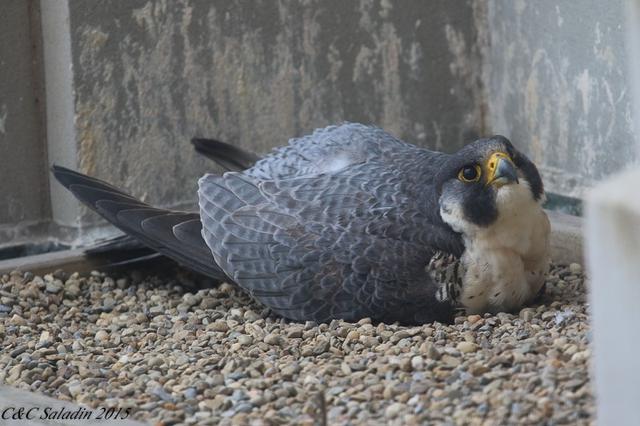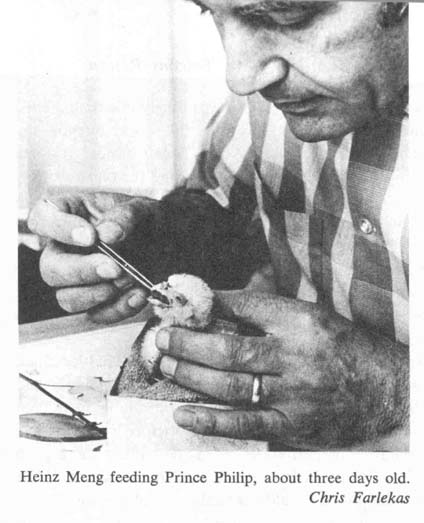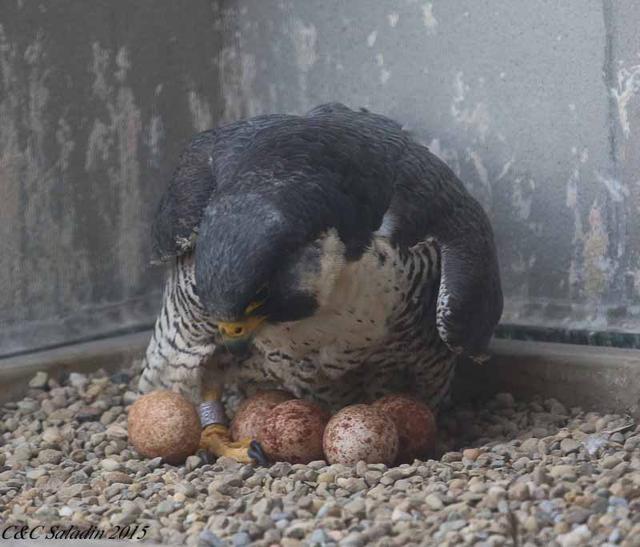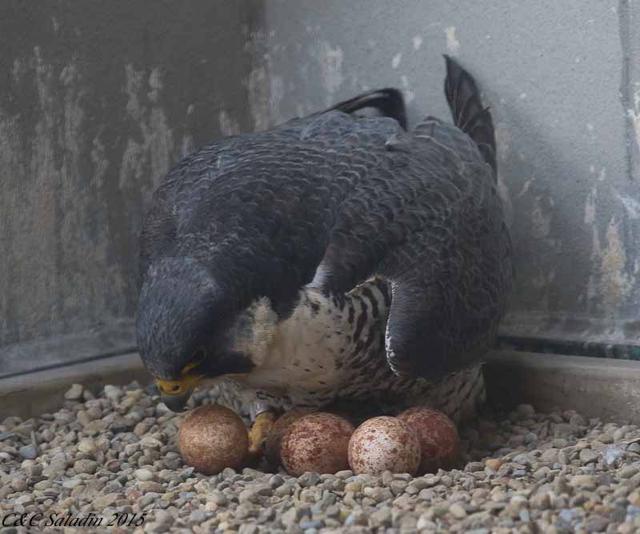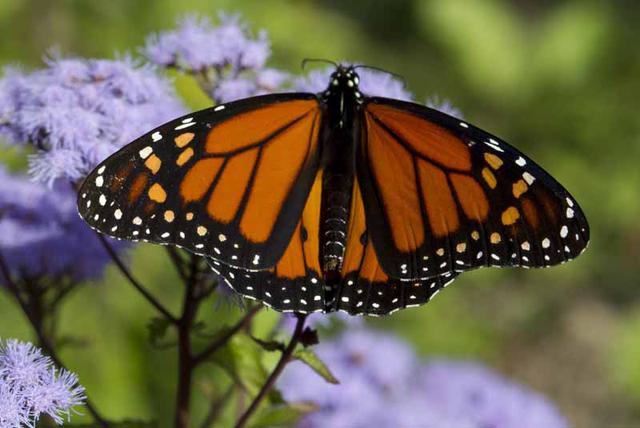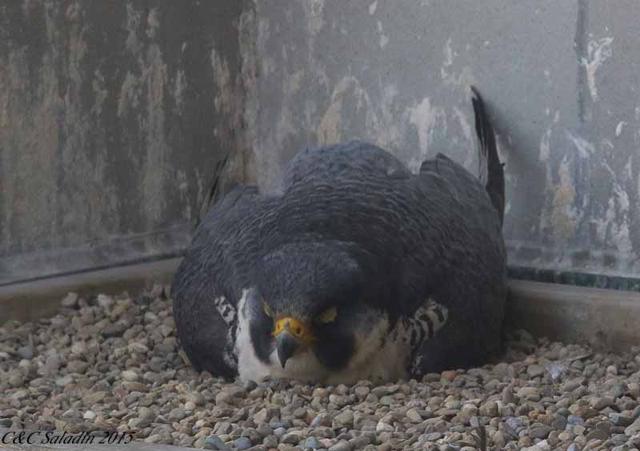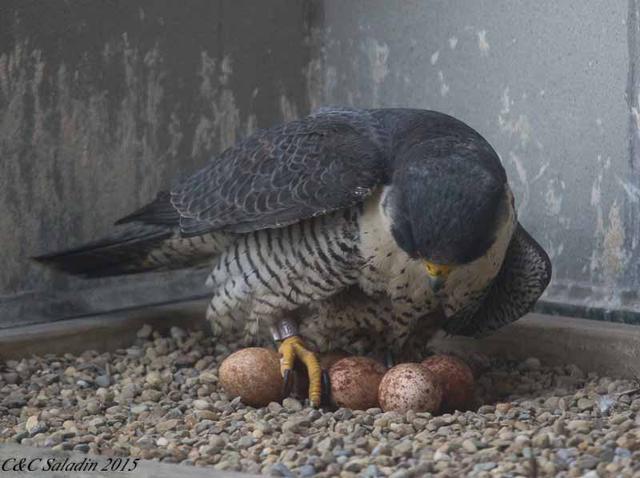FALCON FLASH
Dateline: Cleveland, Ohio
April 22, 2015
Click here to read what happened earlier
Mrs. S continues, “Those watching may be noticing that just after laying Newton was hesitant to come off the eggs to allow Boomer to incubate. This is by design, as the tiercel is keyed into his role as provider while the female starts the nest. The female's brood patches develop sooner than the male’s and with her bigger
body she is better equipped to cover the clutch. And then we saw that Boomer began taking regular and routine "shifts" on the eggs. As an experienced mate, he shows that male and female peregrines typically share incubation duties (as mentioned, with variation in the length and frequency of the tiercel's "shifts"
among different pairs).
On Earth Day let’s commit ourselves to the future of all species. Here’s something you can do. One of America’s favorite butterflies, the Monarch, is disappearing across America. In fact, 90% of its population has disappeared in recent years – that’s almost one billion beautiful butterflies that have vanished.
It’s Earth Day! Celebrating Earth Day today as we watch Newton and Boomer incubate their eggs reminds us of how fragile and how grand nature can be.
The first of a number of “captive breeding” programs began at Cornell University in 1970 under the direction of Dr. Tom Cade. The Peregrine Fund, a leader in the effort to save the peregrine falcon and now saving raptor species around the world, began in 1970 when two schoolboys sent money to Dr. Cade to save the
peregrines from extinction and he deposited it into a fund for that purpose.
After chicks were hatched in captivity, some were placed in the nests of falcon couples who had lost their own fragile eggs, and the foster parents would raise the captive bred chicks. Sometimes the chicks were raised in captivity by humans and then "hacked" into the wild. Hacking is a gradual release of the birds into the wild. This wasn’t easy for humans to do. The captive bred chicks were placed back onto cliffs, sometimes by humans climbing mountains and sometimes by helicopter. Scientists also realized that skyscrapers might be a good place to hack the cliff-dwelling peregrines – they tried it and it was a success. Today peregrine falcons have moved into cities across North America.
Now that DDT is no longer in the ecosystem, peregrine falcon eggs once again have strong eggshells, yet the parents must still be careful with them. Nest monitor, Mrs. Saladin, writes of the following pictures, “….. Newton's mastery of delicate movements around the eggs as she shifts and steps carefully in between them, making sure they all get "equal time" in her brood patches is a subtle, yet beautiful thing to witness”.
atch improperly”.
A big reason for the disappearance of the Monarch is that it needs one plant for its survival – the milkweed. Milkweed plants have been killed as weeds across North America, both by farmers and by everyday people thinking they are weeds. But sometimes we need a common plant – aka weed – in order to have beautiful
butterflies. The U.S. Fish and Wildlife Service has announced a new effort called “Save the Monarchs” that is encouraging people across North America to plant milkweed plants in their gardens. You can ask your parents, friends or teachers to buy and plant a milkweed plant at home or at school. (The scientific name for milkweed is Asclepias, which you might need to know when you ask for it at the garden store). Then watch your plant for a striped caterpillar eating its leaves which will turn into a beautiful Monarch butterfly. Just like the schoolboys who started the Peregrine Fund with a small donation, you too can make a difference in helping a species.
On Earth Day, we are thankful that the species peregrine falcon has been saved from extinction and is no longer an Endangered Species.
According to Mrs. Saladin, “Based on incubation starting with the third egg (laid on 4-4), we are anticipating hatching to begin approximately May 6-9th”. Here is Newton taking a nap just after she rearranged her eggs.
The comeback of the species peregrine falcon is one of the great success stories of wildlife conservation. By 1975, the species was extinct east of the Mississippi River and there were only 324 known nesting pairs of American peregrine falcons. This was due to the widespread use of a pesticide called DDT. Peregrine falcons are at the top of the food chain and DDT accumulated in falcons due to eating prey
that contained DDT. It caused eggshells to be very thin and the fragile eggs would break under the weight of the parents during incubation. No eggs meant no chicks, and the species nearly disappeared. DDT was banned in the United States in 1972, and in 1973 the peregrine falcon was listed as endangered under the federal Endangered Species Act. For decades, scientists and volunteers from all walks of life raced to save the species.
It was not easy saving a species. At the time, only a few birds of prey had ever been bred successfully in captivity. Here is a picture of Dr. Heinz Meng, with the first peregrine chick hatched in captivity in 1972.
Stay tuned for falcon news…….
To watch the falcons live go to: http://www.falconcam-cmnh.org/news.php
Our thanks to the Cleveland Museum of Natural History for sponsoring the FalconCams.
Photos are courtesy of volunteer peregrine nest monitors, Mr. and Mrs. Saladin.
Photo of a Monarch butterfly is courtesy of Mr. David Mathies
Click here to read what happened next

